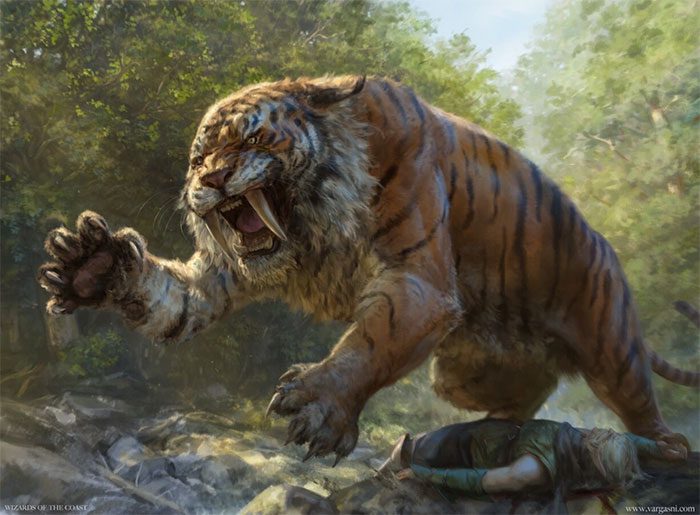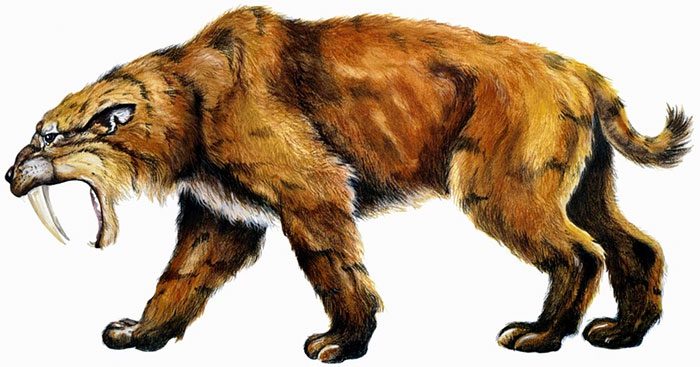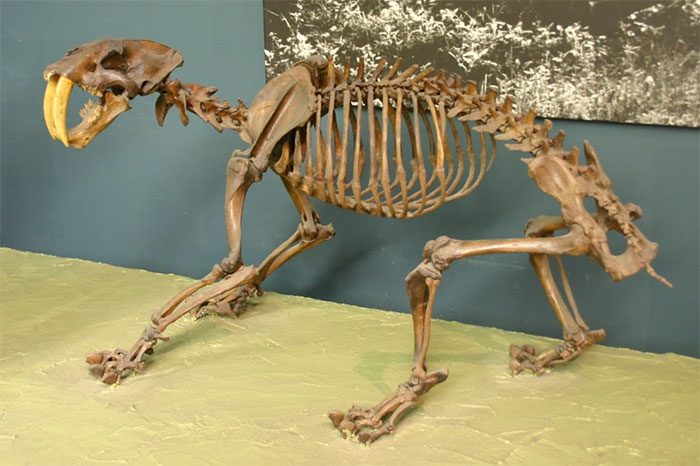With their long canines and impressive physique, saber-toothed cats have become one of the most well-known prehistoric animals outside of dinosaurs.
Unknown Facts About Saber-Toothed Cats
- 1. “Saber-toothed cat” is an inaccurate name
- 2. Saber-toothed cats went extinct before mammoths
- 3. Gigantic size
- 4. Thick fur like a bear
- 5. Lived like lions
- 6. Enemies of ancient humans
- 7. Canines grew twice as fast as modern wild cats
- 8. Lifespan up to 40 years
- 9. Not particularly strong jaws
- 10. Brain structure similar to modern cats
Among ancient predatory species, saber-toothed cats are among the most famous. They lived around 10,000 years ago in North America, boasting incredibly developed legs, muscular bodies, and two long, sharp canines. With these deadly weapons, they often roamed tall grasslands, employing ambush tactics to bring down gigantic prey.

Saber-toothed cats lived 10,000 years ago in North America.
1. “Saber-toothed cat” is an inaccurate name
Based on fossils excavated in Brazil, scientists have classified saber-toothed cats (Smilodon) within the Felidae family, meaning they are not closely related to modern tigers or cats. Interestingly, they are still commonly referred to as saber-toothed cats.
2. Saber-toothed cats went extinct before mammoths
At the same time saber-toothed cats went extinct, the American lion (Panthera atrox) also vanished around 10,000 years ago. Meanwhile, the famous Ice Age creature, the woolly mammoth (Mammuthus primigenius), went extinct just 4,000 years ago.
3. Gigantic size
Smilodon had a more robust body than any other feline predator, with particularly well-developed forelimbs and exceptionally long upper canines. Among them, the S. populator species found in South America was the largest, weighing up to 400 kg and standing 120 cm tall.
4. Thick fur like a bear
To survive the icy climate of the Pleistocene, the Smilodon had a thick coat similar to that of a bear, with a slightly yellowish beige color akin to that of a lion. This fur complemented their muscular build, broad chest, and short tail, further distinguishing them from modern tigers.

Saber-toothed cats had thick fur like a bear, with a slightly yellowish beige color similar to lions.
5. Lived like lions
Research suggests that saber-toothed cats lived in enclosed habitats such as thickets and dense forests, allowing them to hide and ambush their prey. Although it is still unclear whether they were social creatures, it is likely that they behaved similarly to modern lions.
6. Enemies of ancient humans
Some restored skulls of prehistoric humans show marks from long canines, believed to be from saber-toothed cats. This evidence suggests that humans and saber-toothed cats may have attacked each other during the Pleistocene. A compelling hypothesis also posits that humans hunted Smilodon to extinction, as they had no natural predators before humans.
7. Canines grew twice as fast as modern wild cats
Studies indicate that the canines of saber-toothed cats grew twice as fast as most modern wild cat species. By the age of 3, they had already replaced their baby teeth with fully developed canines capable of easily tearing flesh.
8. Lifespan up to 40 years
Since they are extinct, the exact lifespan of saber-toothed cats remains a question. However, many scientists agree that they could have lived between 20 to 40 years in the wild, based on studies of fossil samples.

Fossil of saber-toothed cat at the National Museum of Natural History, Washington, D.C. (USA).
9. Not particularly strong jaws
Despite having larger and sharper teeth, the bite force of saber-toothed cats was three times weaker than that of modern wild cats. Additionally, it is believed that lions and leopards evolved to have stronger bites to compensate for their smaller teeth.
10. Brain structure similar to modern cats
Although proven to be a different species, saber-toothed cats and modern cats share similar brain functioning mechanisms. This indicates an increasing complexity of senses such as vision, hearing, and muscle coordination. However, Smilodon had relatively small eyes that were not forward-facing like those of modern cats.





















































